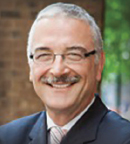As ASCO Annual Meeting attendees know by now, clinicians don’t have to be at McCormick Place to hear practice-changing findings and forward-looking advances in the field of oncology. Interesting content was no exception at the 2021 conference, so in addition to covering the biggest news from the meeting in other articles, The ASCO Post brings you these brief news summaries.
Maintenance Daratumumab Proves Beneficial in Multiple Myeloma
Part 2 of the CASSIOPEIA trial in 866 patients with newly diagnosed multiple myeloma demonstrated benefit for maintenance daratumumab after treatment with bortezomib, thalidomide, and dexamethasone (V-Td) with or without daratumumab and autologous stem cell transplant. At a median follow-up of 35 months, median progression-free survival was not reached in patients receiving daratumumab, whereas it was 46.7 months with observation (hazard ratio [HR] = 0.53; P < .0001), reported Philippe Moreau, MD, of the University Hospital Hotel Dieu in Nantes, France.1

Philippe Moreau, MD
Part 2 of CASSIOPEIA compared daratumumab at 16 mg/kg every 8 weeks (a reduced frequency compared with standard dosing) vs observation for a fixed duration of 2 years in patients who achieved at least a partial response to induction/consolidation therapy in Part 1 of the trial. In Part 1, multiple outcomes were improved in patients receiving daratumumab plus V-Td vs V-Td alone.
The primary endpoint of Part 2 was progression-free survival after the second randomization. This was significantly improved for patients not receiving daratumumab as induction/consolidation who then received daratumumab maintenance vs observation, but not for patients initially treated with daratumumab in Part 1, Dr. Moreau reported.
In addition to the progression-free survival benefit, daratumumab maintenance was associated with multiple improvements:
- Complete response or better: 72.9% vs 60.8% (odds ratio [OR] = 2.17; P < .0001)
- Minimal residual disease (MRD) negativity: 58.6% vs 47.1% (OR = 1.80; P = .0001).
- Time to disease progression: not reached vs 46.7 months (HR = 0.49; P < .0001)
- Second progression-free survival: not reached vs not reached (HR = 0.62; P = .0298).
“Prespecified analysis showed significant interaction between maintenance and induction/consolidation therapies” Dr. Moreau said. “In addition, updated results from Part 1 support the early use of daratumumab-containing regimens as induction/consolidation.”
Fluorescent Marker Aids Detection in Ovarian Cancer
In one-third of women undergoing surgery for ovarian cancer, the use of a fluorescent marker, pafolacianine sodium injection (OTL38), led to the detection of additional lesions not observed by conventional means or slated for resection, results of a prospective phase III showed.2 The results suggest this compound, which highlights folate receptors on ovarian cancer cells, could serve as a real-time adjunct to current imaging practice in ovarian cancer surgery and thus help surgeons achieve complete tumor debulking, said Janos L. Tanyi, MD, PhD, of the University of Pennsylvania.

Janos L. Tanyi, MD, PhD
“Intraoperative tools that can enhance the visualization of tumors during surgery are needed to help surgeons achieve complete cytoreduction,” Dr. Tanyi said. “This phase III trial met its primary endpoint, demonstrating that OTL38 injection with near-infrared fluorescent imaging detected additional cancer lesions not otherwise planned for resection in 33% of patients (P < .001). One-third of the patients in this study would otherwise be left behind with the use of visual and tactile methods of detection alone.”
The phase III open-label study enrolled 150 women (n = 109 in the efficacy analysis) with folate receptor–positive ovarian cancer undergoing primary debulking surgery (53%), interval debulking (36%), or surgery for recurrent disease or other reason (11%). For patients undergoing interval debulking surgery, the outcome with OTL38 was even more impressive, with the discovery of additional lesions in 39.7%. During primary cytoreductive surgery, 17.9% of patients were found to have additional lesions.
After infusion of pafolacianine, surgeons examined the ovarian tissue first under white light with palpation and then under near-infrared fluorescent imaging, with patients serving as their own controls. A surgical plan was developed both before and after applying OTL38, with the plan updated based on findings. Resected tissue was examined by blinded central review, yielding a total of 752 lesions assessed. The use of the marker resulted in a revision of the surgical plan in 56% of patients, achieved more complete debulking in 50% of patients, and led to complete (R0) resections in 62%.
In March 2021, the U.S. Food and Drug Administration (FDA) accepted a new drug application for pafolacianine sodium injection under Priority Review.
The manufacturer, On Target, is also assessing pafolacianine sodium injection in the ongoing phase III ELUCIDATE trial in lung cancer.
Adavosertib Effective in PARP-Resistant -Ovarian Cancer
The Wee1 inhibitor adavosertib, given alone or in combination with olaparib, was effective in patients with poly (ADP-ribose) polymerase (PARP)-resistant ovarian cancer in the phase II EFFORT trial, presented by Shannon Neville Westin, MD, of The University of Texas MD Anderson Cancer Center.3
EFFORT was a randomized noncomparative study of oral adavosertib with or without olaparib in women with PARP-resistant ovarian cancer—an increasingly important subset in ovarian cancer. This trial was based on early

Shannon Neville Westin, MD
research demonstrating that resistance to PARP inhibitors may be reversed by the inhibition of Wee1, a protein kinase that has become a viable therapeutic target in cancer due to its role in regulating DNA damage repair pathways and checkpoints. Preclinical studies suggest that inhibition of Wee1 and PARP is potentially synergistic.
“Arguably, the majority of patients with ovarian cancer will receive a PARP inhibitor at some point during their cancer therapy, whether that be in the front-line setting, as second-line maintenance, or as a treatment strategy in recurrence,” said Dr. Westin. “With the increased use of PARP inhibitors, we are seeing an increased incidence of resistance to PARP inhibitors, and this can occur through multiple different mechanisms.”
For the phase II EFFORT study, investigators randomly assigned 80 women with disease progression after PARP inhibitor therapy to receive either adavosertib alone or in combination with olaparib. Treatment with adavosertib alone led to responses in 23% of patients; in combination with olaparib, responses were observed in 29%. Median duration of response was 5.5 months and 6.4 months, respectively.
With adavosertib alone, a 63% clinical benefit rate was seen, and this benefit occurred irrespective of BRCA mutation status. Similarly, in the adavosertib/olaparib arm, despite a median of four prior lines of therapy, patients were able to stay on study for more than 60 days, achieving an 89% clinical benefit, Dr. Westin noted, adding that “deep and durable responses are possible” with or without olaparib. Toxicities were generally manageable with supportive care and dose interruptions or reduction.
Dalpiciclib: New CDK4/6 Inhibitor for Breast Cancer
The investigational cyclin-dependent kinase (CDK) 4/6 inhibitor dalpiciclib, given with fulvestrant, led to a reduction in the risk of disease progression or death by 58% over placebo plus fulvestrant in patients with advanced hormone receptor–positive, HER2-negative breast cancer progressing after endocrine therapy in the phase III DAWNA-1 trial.4 The results were reported by Binghe Xu, MD, PhD, of the National Cancer Center/Cancer Hospital, Chinese Academy of Medical Sciences and Peking Union Medical College in Beijing.

Binghe Xu, MD, PhD
DAWNA-1 randomly assigned 361 patients (2:1) to receive -dalpiciclib or placebo with fulvestrant. After a median follow-up of 10.5 months, patients receiving dalpiciclib plus fulvestrant achieved a median progression-free survival of 15.7 months vs 7.2 months with placebo plus fulvestrant (HR = 0.42; 95% confidence interval [CI] = 0.31–0.58).
“Generally, progression-free survival in all prespecified subgroups favored dalpiciclib plus fulvestrant and showed a hazard ratio of less than 1, regardless of menopausal status, presence of visceral metastases, or previous lines of endocrine therapy,” Dr. Xu reported.
The prevalence of grade ≥ 3 adverse events was higher in the dalpiciclib group, with neutropenia seen in 84% and 62% developing leukopenia; no patient in the placebo group experienced these events. The number of adverse events leading to treatment discontinuation or death, however, was comparable between the arms.
PALOMA-3 and MONALEESA-3 Survival Updates
Investigators from two pivotal phase III CDK4/6 inhibitor trials in breast cancer presented overall survival updates at the ASCO meeting, showing maintenance of a prolonged benefit with palbociclib in PALOMA-35 and ribociclib in MONALEESA-3.6 The drugs were studied in combination with fulvestrant in postmenopausal patients with hormone receptor–positive/HER2-negative advanced breast cancer.
In the PALOMA-3 trial, Massimo Cristofanilli, MD, of Northwestern University in Chicago, reported that after a median follow-up of 73.3 months, median overall survival is now 34.8 months with palbociclib/fulvestrant vs 28.0 months with fulvestrant alone (HR = 0.81; 95% CI = 0.65–0.99). The 5-year overall survival rates are 23.3% and 16.8%, respectively.

Massimo Cristofanilli, MD

Dennis Slamon, MD, PhD
Dennis Slamon, MD, PhD, of the University of California Los Angeles, reported that after a median follow-up of 56.3 months, median overall survival for ribociclib/fulvestrant is now 53.7 months vs 41.5 months with fulvestrant alone (HR = 0.73; 95% CI = 0.59–0.90) in MONALEESA-3.6 By treatment line, median overall survival was not reached with ribociclib/fulvestrant and was 51.8 months with fulvestrant for first-line therapy and 39.7 months vs 33.7 months, respectively, for second-line therapy, Dr. Slamon reported.
Oral SERD Rintodestrant Shows Activity in Advanced Breast Cancer
Future partners for CDK4/6 inhibitors may be oral selective estrogen receptor degrader (SERDs). Interest in these compounds has been high and, at the ASCO meeting, a phase I study reported promising antitumor activity for the SERD rintodestrant in estrogen receptor–positive, HER2-negative advanced breast cancer.7 When partnered with palbociclib, rintodestrant doubled the clinical benefit rate to 60% vs 30% for rintodestrant as monotherapy. Efficacy was shown even in patients with tumors harboring ESR1 variants, which are known to modulate resistance to endocrine therapy, reported Marina Maglakelidze, MD, of Arensia Exploratory Medicine in Tbilisi, Georgia.

Marina Maglakelidze, MD
In the phase I first-in-human study of the drug, 40 patients who experienced disease progression on endocrine therapy received rintodestrant and palbociclib once daily for 21 days in 28-day cycles. Median duration of treatment was 6.2 months, median progression-free survival was 7.4 months, and, among patients with early relapse, the clinical benefit rate was 73%. The combination was well tolerated. Of note, no ocular toxicity nor bradycardia was observed in the study, both of which are common adverse events seen in trials of other oral SERDs, the investigators noted.
Tisagenlecleucel Yields Encouraging Efficacy in Difficult-to-Treat Follicular Lymphoma
Tisagenlecleucel achieved complete responses in two-thirds of adults with heavily pretreated follicular lymphoma in the single-arm, phase II ELARA trial.8 The overall response rate in these patients with relapsed or refractory disease was 86%, and the complete response rate was 66% on treatment with tisagenlecleucel, a chimeric antigen receptor (CAR) T-cell therapy.
At a median follow-up of 11 months, median duration of response, progression-free survival, and overall survival were not reached. At 6 months, the rate of progression-free survival was 76%.
“These data indicate that tisagenlecleucel is an effective therapy for patients with relapsed or refractory follicular lymphoma, including high-risk subgroups,” said Stephen J. Schuster, MD, of the University of Pennsylvania Abramson Cancer Center, Philadelphia.

Stephen J. Schuster, MD
Follicular lymphoma is often fairly indolent, and the majority of patients do not require aggressive therapy, but patients who relapse within 2 years of first-line chemotherapy have a 5-year survival of about 50%. Responses tend to decrease with each subsequent line of therapy.
ELARA was a phase II, international, single-arm trial that enrolled 98 patients with follicular lymphoma treated with at least two prior lines of therapy or for whom autologous stem cell transplant was not effective. Among these patients, 97 received an infusion of tisagenlecleucel and were evaluable for safety; 94 were evaluable for efficacy. All patients had grade 1–3A follicular lymphoma with no evidence of histologic transformation. Prior anti-CD19 therapy or allogeneic transplant was not allowed.
Median age was 57 (25% were ≥ age 65). Two-thirds had bulky disease at baseline, 85% had stage III or IV disease, and 60% had a Follicular Lymphoma International Prognostic Index (FLIPI) score ≥ 3, indicating high risk. Patients had received a median of four prior therapies (28% had five prior lines). A total of 75% were refractory to two or more lines of prior therapy.
Following high-dose chemotherapy with fludarabine plus cyclophosphamide, patients received an infusion of tisagenlecleucel. About 20% were treated as outpatients.
Treatment-related adverse events were reported in 77.3% of patients. Grade 3 or 4 treatment-related adverse events occurred in 45.4% and serious adverse events, in 28.9%. Three deaths occurred during the trial but were not considered to be associated with treatment. A total of 50% of patients treated with tisagenlecleucel experienced cytokine-release syndrome at a median of 4 days after treatment. These events were deemed low grade. Another 9.3% of patients had immune effector cell–associated neurotoxicity; one event was grade 3.
The majority of cytokine-release syndrome events (75%) and 100% of the immune effector cell–associated neurotoxicity events were reported in patients with bulky disease. These events resolved with appropriate management. There was no association between dose level and cytokine-release syndrome or immune effector cell–associated neurotoxicity.
CAR T-Cell Therapy Yields High Response Rates in Relapsed ALL
High and durable responses were seen with the CAR T-cell therapy brexucabtagene autoleucel in heavily pretreated adults with relapsed or refractory B-cell–precursor acute lymphoblastic leukemia (B-ALL), according to the results of the phase I/II ZUMA-3 study.9 Results of the trial were published in The Lancet to coincide with the presentation at the 2021 ASCO Annual Meeting.10
At a median follow-up of 16.4 months, 71% of patients had a complete response or a complete response with incomplete hematologic recovery. A majority of responses were associated with achieving undetectable MRD.
“The efficacy and safety profile support the promising role of brexucabtagene autoleucel to provide long-term clinical benefit in adults with relapsed B-cell ALL,” said Bijal Shah, MD, of Moffitt Cancer Center, Tampa, Florida.
About 40% to 50% of adults with B-ALL relapse after treatment and have a poor prognosis. After first salvage therapy, the 1-year overall survival rate is 26%, and rates are lower with each subsequent line of therapy.

“The efficacy and safety profile support the promising role of brexucabtagene autoleucel to provide long-term clinical benefit in adults with relapsed B-cell ALL.”— Bijal Shah, MD
Tweet this quote
Brexucabtagene autoleucel received accelerated approval for relapsed or refractory mantle cell lymphoma from the FDA in 2020.
The phase I portion of the trial achieved an overall rate of complete response or complete response with incomplete hematologic recovery in 83% of patients, with a manageable safety profile. The recommended dose going forward was 1 × 106 CAR T cells/kg.
Phase II included 71 patients with relapsed or refractory B-ALL. A total of 55 patients received brexucabtagene autoleucel. Of these patients, 47% had been treated with three or more prior therapies.
In phase II, the rate of complete response or complete response with incomplete hematologic recovery was 70.9% (complete response rate of 56.4%). Among responders, 97% were MRD-negative, andthe median time to response was 1.1 months. A total of 10 patients went on to allogeneic stem cell transplant (9 with complete response or complete response with incomplete hematologic recovery). Responses were consistent among subgroups by age, by previous treatment, and with prior allogeneic transplant. The exception was patients with a bone marrow blast burden greater than 75%.
Median overall survival was 18.2 months and was not reached among responders.
The most common grade ≥ 3 adverse events were anemia or fever. Grade ≥ 3 or cytokine-release syndrome and immune effector cell–associated neurotoxicity each occurred in about one-quarter of patients and were reversible with treatment. Grade 5 events were reported in 10 patients (2 were treatment-related).
Pembrolizumab Plus Gemcitabine/Radiotherapy Promising in Muscle-Invasive Bladder Cancer
Pembrolizumab plus gemcitabine and concurrent hypofractionated radiotherapy appears to be an effective bladder-sparing regimen in patients with muscle-invasive bladder cancer, according to the results of a phase II trial.11
The 12-week complete response rate was 100% in the safety cohort (n = 6) and 77% in the efficacy cohort (n = 48). The 1-year bladder-intact disease-free survival was 88% in the efficacy cohort. The rate increased to 89% when the safety cohort was added. At 1 year, the rate of metastasis-free survival was 85% for all 54 patients. The primary endpoint of the trial was 2-year bladder-intact disease-free survival, so these results are considered preliminary.
Based on these findings, said lead investigator Arjun V. Balar, MD, “Trimodality bladder preservation therapy is an effective nonsurgical option for patients with muscle-invasive bladder cancer and curative intent.” Dr. Balar is Genitourinary Medical Oncology Director at NYU Langone’s Perlmutter Cancer Center, New York.

“Trimodality bladder preservation therapy is an effective nonsurgical option for patients with muscle-invasive bladder cancer and curative intent.”— Arjun V. Balar, MD
Tweet this quote
The study included patients with cT2 to T4aN0M0 muscle-invasive bladder cancer who were not eligible for (n = 15) or declined cystectomy (n = 39). Treatment was with a single dose of pembrolizumab at 200 mg followed in 2 to 3 weeks by transurethral resection of the bladder tumor and whole-bladder radiotherapy, with gemcitabine at 27 mg/m2 twice a week and pembrolizumab every 3 weeks for three doses.
The majority of treatment-related toxicities in the efficacy cohort were grade 1 or 2. Fatigue, nausea, diarrhea, urinary incontinence, rash, decreased platelets, and anorexia occurred in 20% or more of patients. Grade 3 or 4 treatment-related toxicities were diarrhea, decreased lymphocyte count, colitis, fatigue, anemia, urinary tract pain, hypokalemia, hyponatremia, urinary tract infection, neutropenia, febrile neutropenia, protein-losing enteropathy, immune-related polyneuropathy, and colonic perforation. There was one death not related to study treatment.
Pembrolizumab-related toxicities observed in 10% of more of the efficacy cohort included grade 1 or 2 fatigue, rash, liver abnormalities, and pruritus. Grade 3 pembrolizumab-related toxicities included protein-losing enteropathy, immune-related polyneuropathy, neutropenia, and urinary tract infection. Nine patients (19%) required corticosteroids for management of an immune-related event.
Ongoing randomized studies are exploring further the role of immunotherapy plus bladder-preservation therapy.
5-Year Results From KEYNOTE-052 in Advanced Bladder Cancer
The 5-year follow-up of the single-arm, multisite, open-label KEYNOTE-052 trial showed that pembrolizumab continued to have robust antitumor activity in patients with advanced urothelial cancer who were ineligible for cisplatin therapy.12 More responses were seen in patients with PD-L1 expression, as ascertained by a Combined Positive Score (CPS) ≥ 10.
The confirmed objective response rate was 47.3% in those with a CPS ≥ 10 and 20.7% in patients with a CPS < 10. Median duration of response was not reached in the CPS ≥ 10 group and was 21.2 months in those with a CPS < 10. More than half of patients with a CPS ≥ 10 (57.6%) achieved a duration of response lasting at least 48 months compared with 27.4% of those with a CPS < 10. Median overall survival was 18.5 months vs 9.7 months, respectively. At 36 months, more than double the percentage of patients were alive in the CPS ≥ 10 group: 35.8% and 15.4%, respectively.
“These results show that after up to 5 years of follow-up, pembrolizumab continues to elicit clinically meaningful, durable antitumor activity in cisplatin-ineligible patients with advanced urothelial cancer,” said Peter H. O’Donnell, MD, of the University of Chicago Medicine.

Peter H. O’Donnell, MD
KEYNOTE-052 enrolled 370 patients, with a median age of 74 years; 85.1% had visceral metastases, and 11.6% completed 24 months of therapy.
Treatment-related adverse events were reported in 67.3% of patients. Grade 3 or higher treatment-related adverse events occurred in 21.1% of patients, and there was one death due to myositis.
DISCLOSURE: Dr. Moreau has received honoraria from AbbVie, Amgen, Celgene, GSK, Janssen-Cilag, and Sanofi; and has served as a consultant or advisor to AbbVie, Amgen, Celgene, GSK, Janssen, and Sanofi. Dr. Tanyi reported no conflicts of interest. Dr. Westin has served as a consultant or advisor to Agenus, AstraZeneca, Bioascend, Casdin Capital, Circulogene Theranostics, Clovis Oncology, Curio Science LLC, Eisai, Genentech, Gerson Lehrman Group, GlaxoSmithKline, Medscape, Merck, Novartis, OncLive, Pfizer, Roche, Targeted Oncology, Tesaro, Vaniam Group, Watermark Research Partners, and Zentalis; has received research funding from ArQule, AstraZeneca, Bayer, Clovis Oncology, Cotinga Pharmaceuticals, Novartis, Roche/Genentech, and Tesaro; has an immediate family member who has received research funding from Celgene, Karyopharm Therapeutics, and Kite Pharma; and has received institutional research funding from Bio-Path, GOG Foundation, and Mereo BioPharma. Dr. Xu has participated in a speakers bureau for AstraZeneca, Eisai, Pfizer, and Roche; and has received institutional research funding from Jiangsu Hengrui Pharmaceuticals Co. Ltd. Dr. Cristofanilli has received honoraria from Foundation Medicine and Pfizer; has served as a consultiant or advisor to CytoDyn, Foundation Medicine, Lilly, Menarini, and Novartis; and has received research funding from Angle, Lilly, and Merck. Dr. Slamon has served in a leadership position for BioMarin; holds stock or other ownership interests in Amgen, BioMarin, Merck Sharp & Dohme, Pfizer, Seattle Genetics, and Vertex; has received honoraria from Novartis; has served as a consultant or advisor to Lilly, Novatis, Pfizer, and Seattle Genetics; has received research funding from Novartis and Pfizer; and has been reimbursed for travel, accommodations, or other expenses by BioMarin, Novartis, and Pfizer. Dr. Maglakelidze reported no conflicts of interest. Dr. Schuster has served as a consultant or advisor to AbbVie, Acerta Pharma/AstraZeneca, AlloGene, BeiGene, Celgene, Genentech/Roche, Juno Therapeutics, Loxo Oncology, Nordic Nanovector, Novartis, and Tessa Therapeutics; has received institutional research funding from AbbVie, Adaptive Biotechnologies, Celgene, DTRM, Genentech/Roche, Incyte, Juno Therapeutics, Merck, Novartis, Pharmacyclics, and TG Therapeutics; and holds intellectual property in “Combination therapies of CAR and PD-1 inhibitors (via the University of Pennsylvania with royalties to Novartis).” Dr. Shah has received honoraria from Acrotech/Spectrum, BeiGene, Gilead, and Pharmacyclics/Janssen; has served as a consultant or advisor to Adaptive Biotechnologies, Amgen, BMS/Celgene, Kite/Gilead, Novartis, Pfizer, and Precision Biosciences; has received research funding from Incyte and Kite/Gilead; has received institutional research funding from Jazz Pharmaceuticals; and has been reimbursed for travel, accommodations, or other expenses by AstraZeneca, Celgene, Janssen, Kite/Gilead, Novartis, Pfizer, Seattle Genetics, and Stemline Therapeutics. Dr. Balar has received honoraria from AstraZeneca/MedImmune, Genentech/Roche, and Merck; has served as a consultant or advisor to AstraZeneca/MedImmune, Cerulean Pharma, Dragonfly Therapeutics, Genentech/Roche, GlaxoSmithKline, Incyte, Merck, Nektar, Pfizer/EMD Serono, and Seattle Genetics/Astellas; has received research funding from Seattle Genetics; and has received institutional research funding from AstraZeneca/MedImmune, Genentech/Roche, and Merck.Dr. O’Donnell holds stock or other ownership interests in Allergan; has received honoraria from Astellas Pharma, Atheneum Partners, CLD, Dedham Group, FirstWord Publication, Genentech/Roche, Health Advances, Janssen, Merck, Pfizer, Schlesinger Associates, and Seattle Genetics; has served as a consultant or advisor to Merck; has received institutional research funding from Acerta Pharma, Astellas Pharma, AstraZeneca/MedImmune, Boehringer Ingelheim, Bristol Myers Squibb, Genentech/Roche, Janssen, Merck, and Seattle Genetics; has been reimbursed for travel, accommodations, or other expenses by Genentech/Roche, Janssen, Merck, and Seattle Genetics/Astellas; and holds other relationships with Dragonfly Therapeutics, Janssen, Nektar, and NIH.
REFERENCES
1. Moreau P, Hulin C, Perrot A, et al: Daratumumab maintenance or observation after treatment with bortezomib, thalidomide, and dexamethasone ± daratumumab and autologous stem cell transplant in patients with newly diagnosed multiple myeloma: CASSIOPEIA Part 2. 2021 ASCO Annual Meeting. Abstract 8004. Presented June 8, 2021.
2. Tanyi JL, Chon HS, Morgan MA, et al: Phase 3 randomized, single-dose, open-label study to investigate the safety and efficacy of pafolacianine sodium injection (OTL38) for intraoperative imaging of folate receptor positive ovarian cancer. 2021 ASCO Annual Meeting. Abstract 5503. Presented June 7, 2021.
3. Westin SN, Coleman RL, Fellman BM, et al: EFFORT: A randomized two-arm non-comparative phase II study of adavosertib with or without olaparib in women with PARP-resistant ovarian cancer. 2021 ASCO Annual Meeting. Abstract 5505. Presented June 7, 2021.
4. Xu B, Zhang Q, Zhang P, et al: Dalpiciclib versus placebo plus fulvestrant in HR+/HER2- advanced breast cancer that relapsed or progressed on previous endocrine therapy (DAWNA-1): A multicenter, randomized, phase 3 study. 2021 ASCO Annual Meeting. Abstract 1002. Presented June 5, 2021.
5. Cristofanilli M, Rugo HS, Im SA, et al: Overall survival with palbociclib + fulvestrant in women with hormone receptor-positive, human epidermal growth factor receptor 2–negative advanced breast cancer: Updated analyses from PALOMA-3. 2021 ASCO Annual Meeting. Abstract 1000. Presented June 5, 2021.
6. Slamon D, Neven P, Chia SKL, et al: Updated overall survival results from the phase III MONALEESA-3 trial of postmenopausal patients with HR+/HER2- advanced breast cancer treated with fulvestrant ± ribociclib. 2021 ASCO Annual Meeting. Abstract 1001. Presented June 5, 2021.
7. Maglakelidze M, Bulat I, Ryspayeva D, et al: Rintodestrant (G1T48), an oral selective estrogen receptor degrader, in combination with palbociclib for ER+/HER2– advanced breast cancer: Phase I results. 2021 ASCO Annual Meeting. Abstract 1063. Presented June 5, 2021.
8. Schuster SJ, Dickinson MJ, Dreyling MH, et al: Efficacy and safety of tisagenlecleucel in adult patients with relapsed/refractory follicular lymphoma: Primary analysis of the phase 2 ELARA trial. 2021 ASCO Annual Meeting. Abstract 7508. Presented June 7, 2021.
9. Shah B, Ghobad A, Oluwole O, et al: KTE-X19 for relapsed or refractory adult B-cell acute lymphoblastic leukemia: Phase 2 results of the single-arm, open-label, multicenter, ZUMA-3 study. 2021 ASCO Annual Meeting. Abstract 7002. Presented June 4, 2021.
10. Shah BD, Ghobad A, Oluwole O, et al: KTE-X19 for relapsed or refractory adult B-cell acute lymphoblastic leukaemia: Phase 2 results of the single-arm, open-label, multicentre ZUMA-3 study. Lancet 398:491-502, 2021.
11. Balar AV, Milowsky MI, O’Donnell PH, et al: Pembrolizumab in combination with gemcitabine and concurrent hypofractionated radiation therapy as bladder sparing treatment for muscle-invasive bladder cancer: A multicenter phase 2 trial. 2021 ASCO Annual Meeting. Abstract 4504. Presented June 7, 2021.
12. O’Donnell PH, Balar AV, Vuky J, et al: First-line pembrolizumab in cisplatin-ineligible patients with advanced urothelial cancer: Response and survival results up to five years from the KEYNOTE-052 phase 2 study. 2021 ASCO Annual Meeting. Abstract 4508. Presented June 7, 2021.

